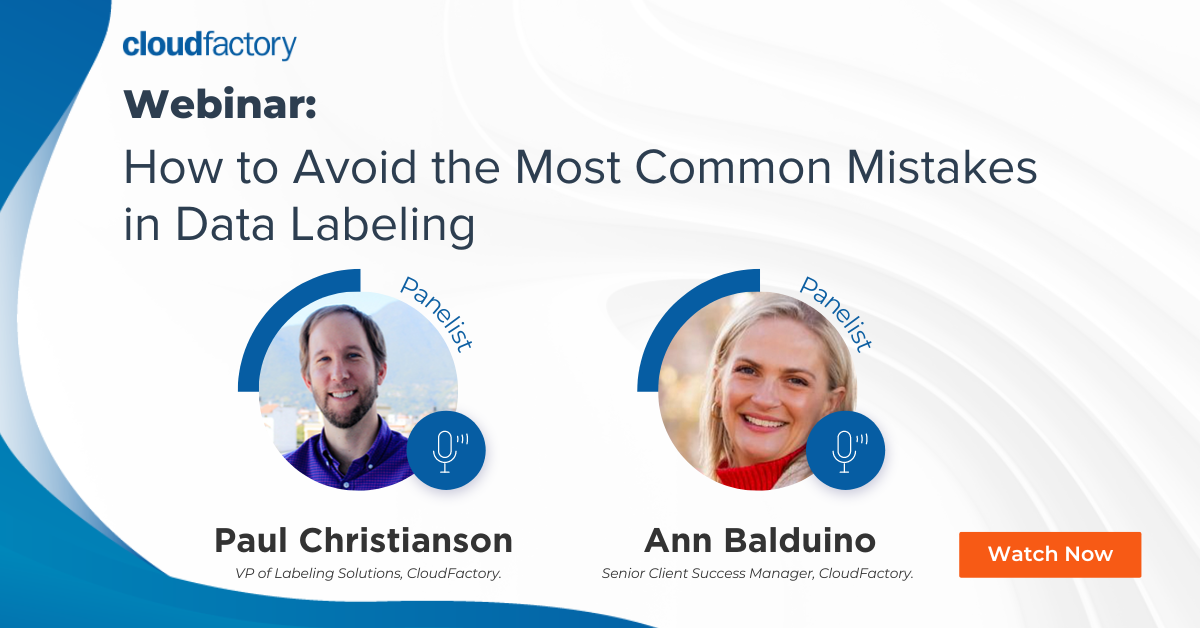It's well-known that over 80% of AI project time is spent on data preparation and labeling. For AI to reach its full potential, innovators must learn from the past so that their initiatives can succeed.
In our latest webinar, How to Avoid the Most Common Mistakes in Data Labeling, Paul Christianson, VP of Labeling Solutions, and Ann Balduino, Senior Client Success Manager, offer insights on how to avoid the most common data labeling pitfalls. The webinar covers the lessons CloudFactory has learned from 15 years of experience delivering over 40 million hours of data work for clients across the globe.
If you don't have time to watch the entire webinar today, this blog post summarizes the 5 most common pitfalls in data labeling:
- Not making the "why" clear upfront
- Delivering unclear annotation guidelines
- Minimizing the importance of HITL
- Over-rotating on automated data labeling
- Not conducting a root cause analysis of quality issues
Pitfall 1: Not making the "why" clear upfront
In order for annotators to apply good judgment, they need good context. If you don't provide the appropriate context for data labeling projects, this can lead to quality issues downstream. Avoid providing opaque data labeling requests with little context, as unclear directives will leave annotators wondering where to start.
Always identify the end product and who the end customers are, as this insight gives clarity and motivation to annotators so they can see how their work makes an impact.
This doesn't mean that you need to go extremely in-depth. The goal is to give annotators a high-level perspective on how their work helps to solve problems.
Pitfall 2: Delivering unclear data annotation guidelines
Avoid ambiguity when providing data annotation guidelines. While outsourcing companies are here to take data labeling work off your plates, the model owner must still be involved in source-of-truth guidelines. You should be able to explain what you need the data labeling service to do and never assume that annotators will automatically understand the task at hand.
During the webinar, Ann shared an instance of a fashion industry client who provided a robust source of truth containing comprehensive visual examples of annotating various clothing items and fabric types. This resource's level of organization and detail facilitated a clear understanding among our annotators and provided them with a convenient reference to clarify annotation inquiries. It also minimized the need for extensive communication between the data labeling team and the client that can come about with unclear guidelines.
Ultimately, the more well-organized your annotations guidelines, the better your output will be.
Pitfall 3: Minimizing the importance of HITL
Minimizing the importance of humans in the loop (HITL) can be disadvantageous. If you think of HITL as "just annotators," you will underestimate their ability to give critical feedback on tools, processes, and workflows.
Paul expands on how when a human labeler is involved, they see model predictions in real time. If predictions aren't improving, humans can flag them immediately. They can also act as a quality control layer bringing to light bugs that clients may not be aware of, saving you resources and time.
Learning the value of having skilled annotators throughout the AI development lifecycle is the best way to avoid this pitfall.
Pitfall 4: Over-rotating on automated data labeling
The industry is moving quickly, and in order to complete, there is a draw to wanting to automate AI projects as much as possible. However, you may find yourself in a tough spot if automation is introduced too early. Using automation without human intervention is setting yourself up to have a large clean-up job on your hands.
Even as automation improves through breakthroughs like Meta's Segment Anything Model, human oversight will still be important in maintaining quality, avoiding bias, and keeping models up to date. Correcting errors in the automated data labeling early on, with involved HITL, saves a lot of wasted time versus running everything through automation and only having humans review once issues arise in the model.
Ensure you are striking the right balance of automation and HITL for your use case.
Pitfall 5: Not getting to the root cause of quality issues
When quality issues arise, it can be easy to immediately assume the root cause of the issue as worker quality, vendor incompetence, or even tool fit. While those things can sometimes be true, there are often root causes at a layer deeper that need to be addressed.
If you look closer, you may find that the real issue is skewness in the data, ambiguity in instructions, or even false interpretation of instructions. Making one small change in the instructions, process, or tool could greatly impact quality and output, even with the same workforce and data labeling service. Ideally, you’ll have a data labeling service with strong feedback loops, QA workflows, and communication so you can address those issues together and determine the root cause.
Be sure to watch the entire webinar to uncover all the details ⬇️



